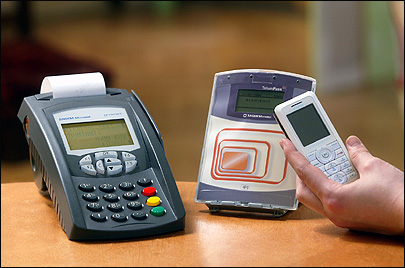Through technology trials, consumers in Amsterdam, France and Finland have been learning to use cell phones with near-field communication (NFC) technology for electronic payments and data exchange. The NFC protocol is a short-range, high-frequency RFID technology designed to expand the capabilities of mobile electronic devices.
In many parts of Europe, however, merchants have invested heavily in a payment protocol called EMV (an acronym derived from the names of the three companies that developed it: EuroPay, MasterCard and Visa). EMV requires consumers to authenticate purchases by keying in a secret code. Until now, European NFC payment trials have not incorporated EMV, but a group of European payment and technology companies this week are launching the first NFC payment trial to utilize the protocol.

In preparation for a pilot taking place in Strasbourg, France, Gemalto, a digital security company based in Amsterdam, and Inside Contactless, a maker of RFID integrated circuits, are readying Sagem my700X model phones for processing payments over NFC, using the EMV protocol. French banking group Crédit Mutuel-CIC worked with MasterCard to develop the payment application, which combines the MasterCard PayPass contactless-payment RFID specification with the EMV protocol. The NFC app will be stored and run on the phone’s subscriber identity module (SIM) card, provided by Gemalto.
The phone’s NFC transponder, made with a Microread chip (Inside’s new integrated circuit for NFC applications), will power the SIM card. Inside designed its Microread chip to exploit power from the NFC reader in the payment terminal to which it is held, allowing users to make payments even if the phone’s battery has expired. This will be the first time the NFC and PayPass applications will be stored on a SIM—other NFC phones store it on a separate chip inside the phone.
The companies expect more than 200 consumers to participate in the trial, in which they will be able to make debit purchases of up to 150 euros at around 50 merchants in and around Strasbourg. After ringing up the items for purchase, sales clerks at participating merchant locations will prompt the Sagem Monetel NFC-payment terminals, installed for the pilot, to perform an NFC transaction. Participants will then hold their phones up to terminals, causing the amount due to appear on the phone’s screen. Following the EMV protocol, the customer will enter a secret code into the phone’s keypad, authorizing the payment before holding the phone up to the reader a second time to confirm it.
This is similar to the process used in making a conventional EMV transaction, which requires the use of a contact-based smart card. EMV, utilized in many parts of Europe, was developed for two reasons: to fight payment fraud (since only the card owner should know the code) and to provide an offline payment authorization to merchants that do not maintain a constant link to a payment network for real-time authorization. EMV is also used in parts of Asia.
The goal of the NFC-EMV pilot project is to test whether NFC-enabled phones could be successfully incorporated into EMV payment systems. The added authorization steps consumers must take with EMV reduce the transaction time-savings that make NFC payments attractive to consumers and merchants alike. However, the ability to use a phone for payments rather than having to carry cash or cards should still attract consumers.
Crédit Mutuel spokesperson Bernard Sadoun says his company will monitor the pilot to ensure the transactions are secure and complete. The firm may expand its involvement in NFC-EMV payment tests in the future. The test will also help MasterCard develop a standard specification for NFC-EMV transaction applications.

